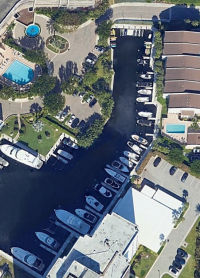jar546
CBO
Scope and Application
Article 555 of the National Electrical Code (NEC), also known as NFPA 70, governs the installation of electrical wiring and equipment in various marine environments, including fixed or floating piers, wharves, docks, floating buildings, and marinas. This includes facilities for small craft repair, berthing, launching, storage, or fueling, as well as docking facilities associated with residential buildings.
Key Definitions
Article 555 includes specific definitions for terms used within its scope, such as berth, boatyard, bulkhead, crane, docking facility, dry stack storage, marina, marina power outlet, monorail, mooring, shore power, slip, and wharf.
Electrical Datum Plane Distances
Service equipment must be installed on land, no closer than 5 feet horizontally from the structure it serves, and elevated at least 12 inches above the electrical datum plane. This ensures the equipment can be easily disconnected in emergencies and prevents water damage.
Maximum Voltage and Load Calculations
Article 555 of the National Electrical Code (NEC), also known as NFPA 70, governs the installation of electrical wiring and equipment in various marine environments, including fixed or floating piers, wharves, docks, floating buildings, and marinas. This includes facilities for small craft repair, berthing, launching, storage, or fueling, as well as docking facilities associated with residential buildings.
Key Definitions
Article 555 includes specific definitions for terms used within its scope, such as berth, boatyard, bulkhead, crane, docking facility, dry stack storage, marina, marina power outlet, monorail, mooring, shore power, slip, and wharf.
Electrical Datum Plane Distances
- Floating Piers: The electrical datum plane must be 30 inches above the water level and at least 12 inches above the deck.
- Tidal Areas: In areas subject to tidal fluctuations, the datum plane must be 2 feet above the highest high tide.
- Non-Tidal Areas: In areas not subject to tidal fluctuations, the datum plane must be 2 feet above the highest normal water level.
Service equipment must be installed on land, no closer than 5 feet horizontally from the structure it serves, and elevated at least 12 inches above the electrical datum plane. This ensures the equipment can be easily disconnected in emergencies and prevents water damage.
Maximum Voltage and Load Calculations
- Voltage Limits: Pier power distribution systems are generally limited to 250 volts phase to phase. Systems may exceed this up to 600 volts if maintained by qualified personnel.
- Load Calculations: Load calculations for service and feeder conductors must follow Part III of Article 220, with additional demand factors permitted for shore power receptacles.
- Transformer Requirements: Transformers must be identified for wet locations and installed above the electrical datum plane.
- Motor Controls: Motors and controls for marine hoists, cranes, and monorails must be installed above the electrical datum plane and use suitable portable power cables.
- Safety Signs: Permanent signs warning of electrical shock hazards must be installed and visible from all approaches to the facility. Signs must state, “WARNING — POTENTIAL SHOCK HAZARD — ELECTRICAL CURRENTS MAY BE PRESENT IN THE WATER.”
- Hazardous Locations: Electrical wiring and equipment at motor fuel dispensing stations and repair facilities must comply with Articles 514 and 511, respectively.
- Bonding Requirements: Non-current-carrying metal parts must be bonded using solid copper conductors, ensuring safety by mitigating electrical potential differences.
- Equipotential Planes: Required adjacent to outdoor service equipment or disconnecting means to prevent step and touch voltages.
- Equipment Installation: Electrical components must be installed at least 12 inches above the deck and not below the electrical datum plane. Splices must use sealed wire connector systems identified for submersion.
- Replacements: Replacement connections must adhere to the same elevation and protection standards.
- Shore Power Receptacles: Must be mounted at least 12 inches above the deck and enclosed in listed marina power outlets or weather-protected enclosures. Each receptacle must be supplied by an individual branch circuit.
- Portable Power Cables: Permitted where flexibility is necessary, and must be supported, secured, and protected from physical damage.
- Feeder Protection: Listed GFPE rated not more than 100 milliamperes is required for feeders on docking facilities.
- Shore Power Receptacles: Must have GFPE rated not more than 30 milliamperes.
- Leakage Current Measurement: Devices for measuring leakage current must be available where more than three shore power receptacles are used.
- Shore Power Disconnection: Each boat must have a disconnecting means, such as a circuit breaker or switch, within 30 inches of the receptacle.
- Emergency Disconnect: Each marina power outlet must have a listed emergency shutoff device that is clearly marked and accessible.
- Equipment Grounding Conductors: Must be wire-type, insulated, and properly terminated. Grounding of both electrical and nonelectrical parts in floating buildings is required.
- Identification: The equipment grounding conductor must be green or green with yellow stripes.
- Service and Feeder Conductors: Each floating building must be supplied by a single set of feeder conductors. Flexibility in the wiring system must be maintained to accommodate water level changes.
- Ground-Fault Protection: The main overcurrent protective device must have ground-fault protection not exceeding 100 mA. Branch-circuit GFCI devices are required for outlets rated 240 volts or less.



